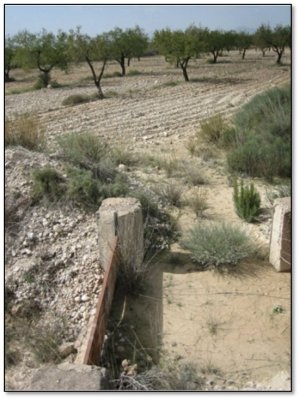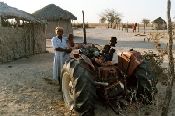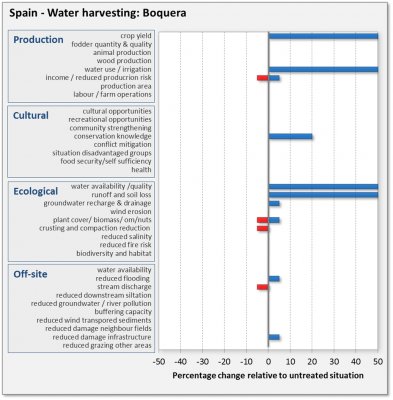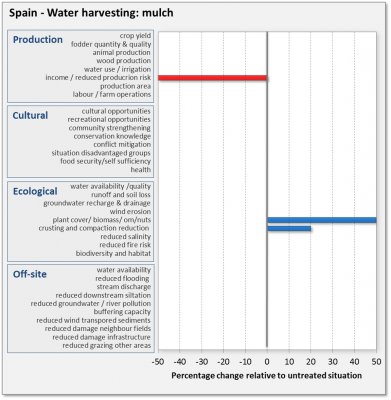|
In the Guadalentín basin in south-eastern Spain, land degradation is considered severe due to a combination of several factors. The semi-arid climate has dry summers followed by intense autumn rainfall, while there is a steep topography and fragile soils. Desertification takes the form of soil erosion and drought. Moreover, considerable land use changes have taken place over the last centuries, which is an important driving force for further degradation in the area. A more efficient way of harvesting rain water might contribute to better yields while at the same time reducing surface runoff and erosion.
Experiments for harvesting water
|
 |
Field trials were carried out to investigate the effects of a more efficient water use on terraced Almond orchards. The first is by collecting surface runoff through a traditional water harvesting technique (i.e. boquera). The second is by applying mulch below the Almond trees. The experimental fields are located in the upper part of the Rambla de Torrealvilla in the ‘Los Alagüeces’ farm (Murcia).
A boquera is a system of partly or fully diverting water from an ephemeral stream (called rambla) to the nearby terraced fields through a series of man-made gateways and channels. To estimate the volume of water during flow events, a probe was installed that registers water height in the channel every 20 seconds.
|
|
In a second experiment a layer of 15 cm mulch was applied below the Almond tree canopies, in order to reduce evaporation. The straw mulch material was imported from further away.
Furthermore a third control field was monitored without any water harvesting techniques.In all three plots soil water content was registered hourly at 35 cm depth, and about monthly for the first 20 cm with FDR equipment.
|
 |
The boquera and control fields were ploughed 3-5 times per year, whereas the field with straw mulch was ploughed only twice a year. The experiment was established in 2008 and data on soil moisture content, inflow amount of water and almond crop harvests were recorded as from 2009 until 2011.
- During the monitoring period of 2 years, a total of 13 events of water entering through the boquera system were recorded (see figure below right). By these events an additional 550mm of water was supplied to a field of 10 ha. Therefore with a mean annual rainfall of about 300mm, the total available water for this field almost tripled.
- The field with boquera inflow has an average soil moisture content in the upper 20 cm that is on average 22.3% higher than in the field with no additional water inflow from water harvesting. However, at 35 cm depth soil moisture content is lower (Figure below left) which is probably due to the development of surface crusts and the high rate of water inflow during events which impede infiltration of water.
- In the mulch treatment and without boquera, soil moisture content was similar or sometimes even slightly lower than under control conditions in the upper 20 cm, whereas at greater depth soil moisture content under mulch was almost always lowest of the three treatments (Figure 3). A possible explanation may be that rainfall is intercepted directly by the mulch and evaporates. The mulch has a positive effect on crust reduction on locations where it is applied.
- The result also shows that the almond harvest in the boquera system is almost double of the harvest under conventional treatment or under mulching.

The results are evaluated from a production, socio-cultural and economic point of view. The bars express the estimated or measured percentage of change with respect to the reference situation. This change can be positive (blue) or negative (red). Note that this evaluation is based on the experiments, on the long term experience of the coordinating team in this area and on consultations with the farmers.
 |
- A lot of farmers show interest in SLM technologies to protect the land, the interest in conservation is improved.
- Despite the implementation and maintenance costs, the boquera increases the benefits enormously (52%) so the farmers will continue using this.
|
3. Mulching is not profitable compared to conventional cultivation practices since it does not increase the yield. Moreover the farmers consider the land not tidy when mulching is applied. As a third disadvantage the mulch would have to be purchased or collected from surrounding natural vegetation, which would then mean increased labour. In both cases this has negative economic consequences.
|
The traditional water harvesting technique does not necessarily improve soil moisture but the crops with shallow root system benefit the high water availability which will increase crop yield.
|
|
Mulching does not increase soil moisture in very dry environment. It is not profitable and not liked by the farmers.
|
|
Additional funds should be available to construct and maintain the traditional boquera system of water harvesting. Not all farmers have access to a functioning system so for a large scale application considerable investments would be needed.
|
|










